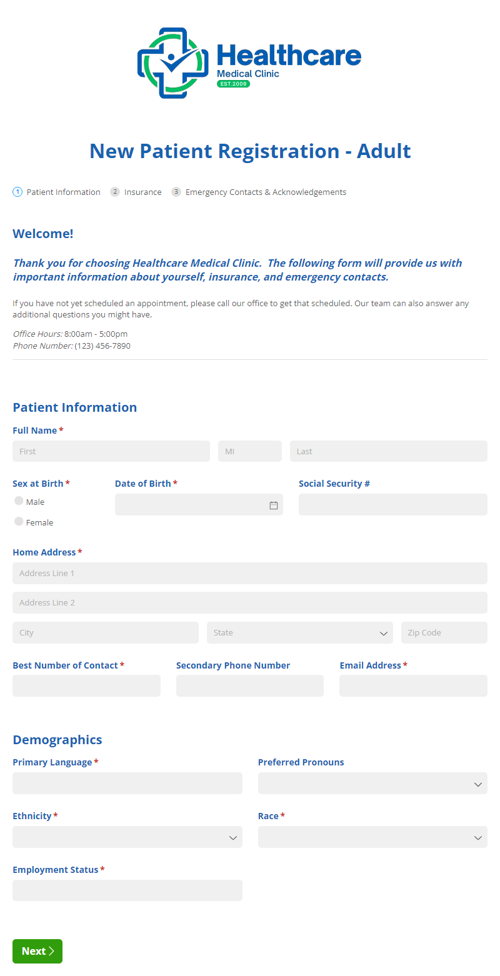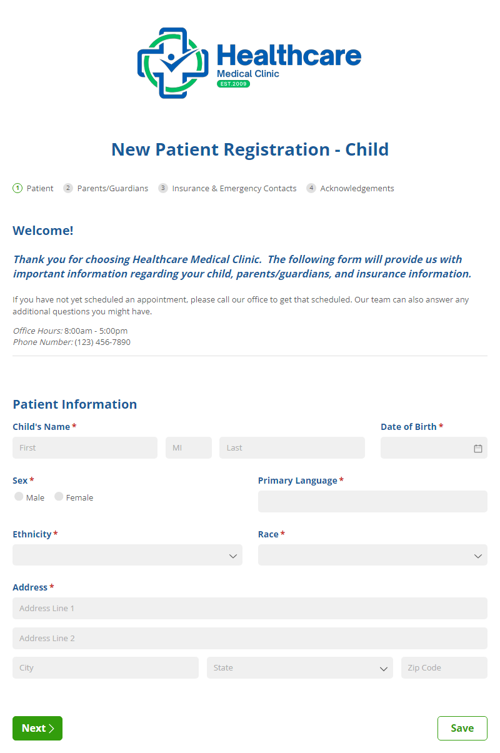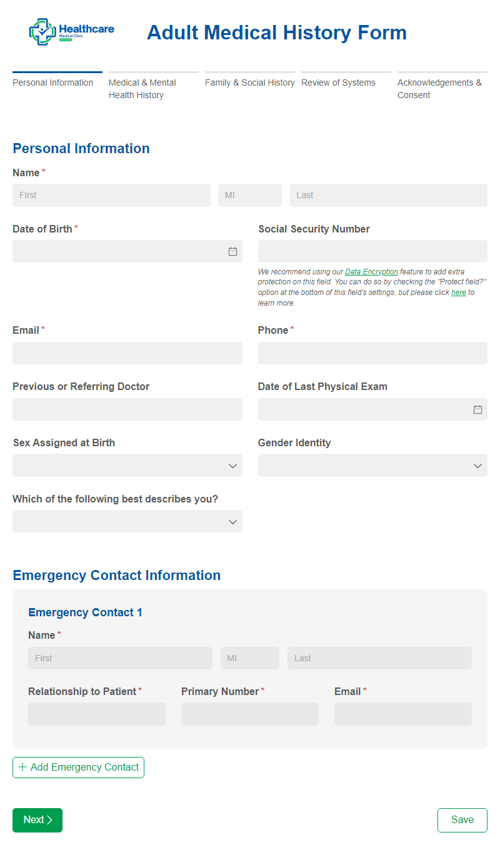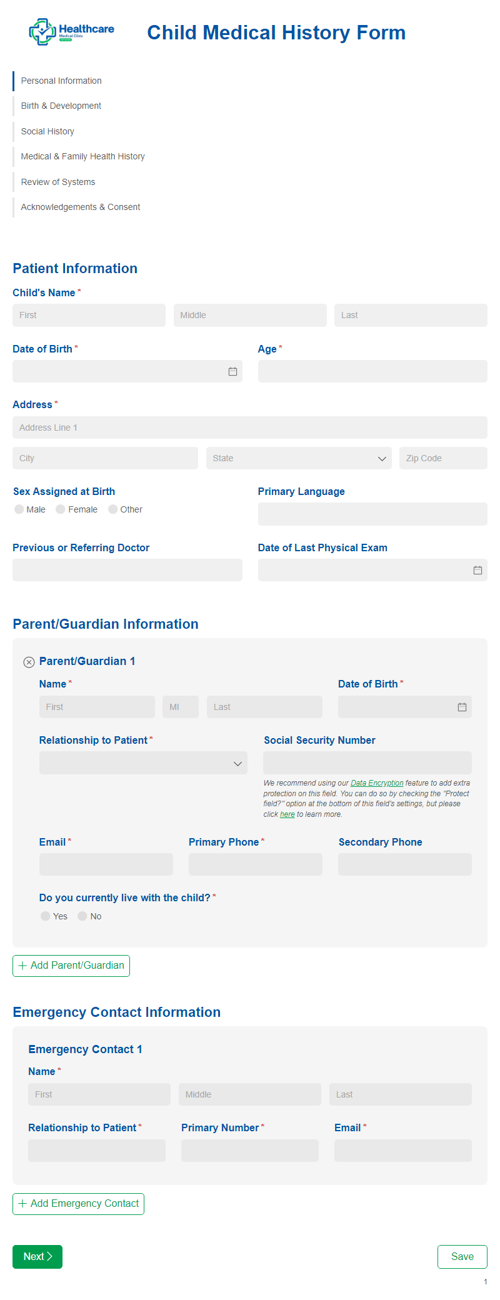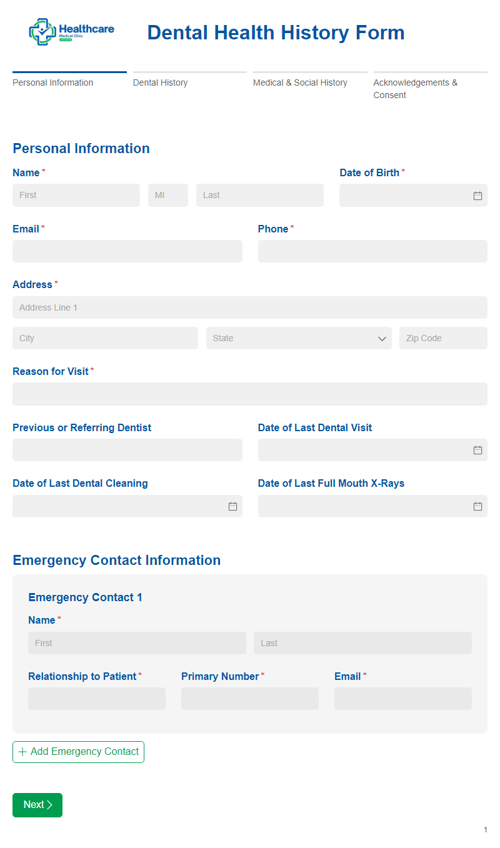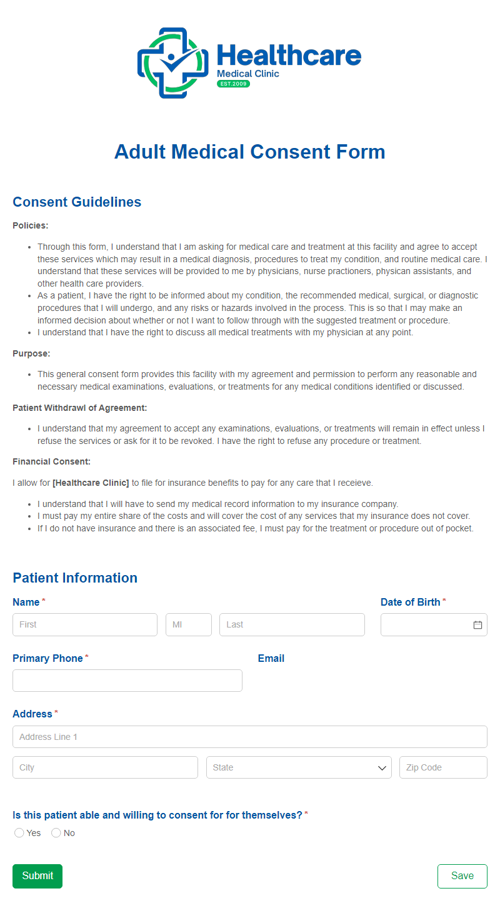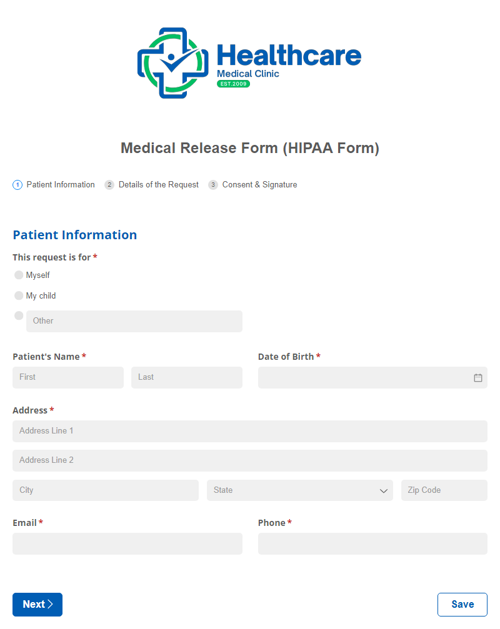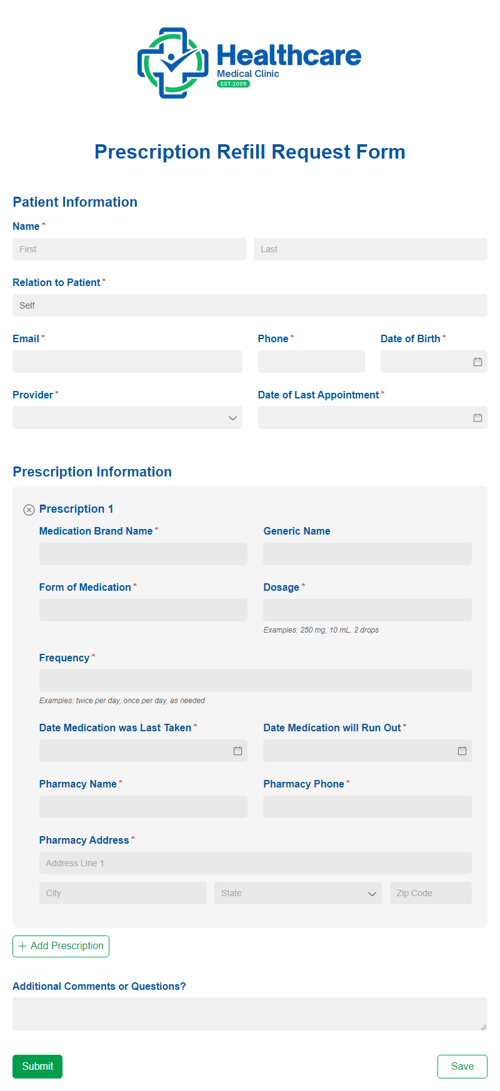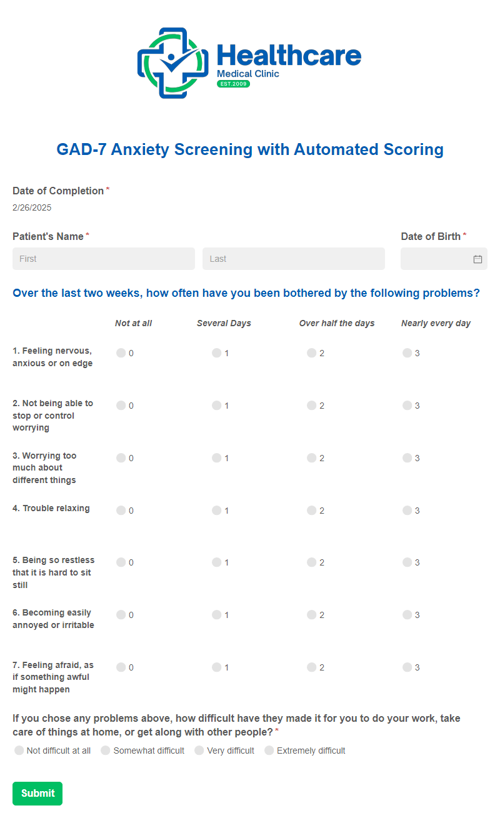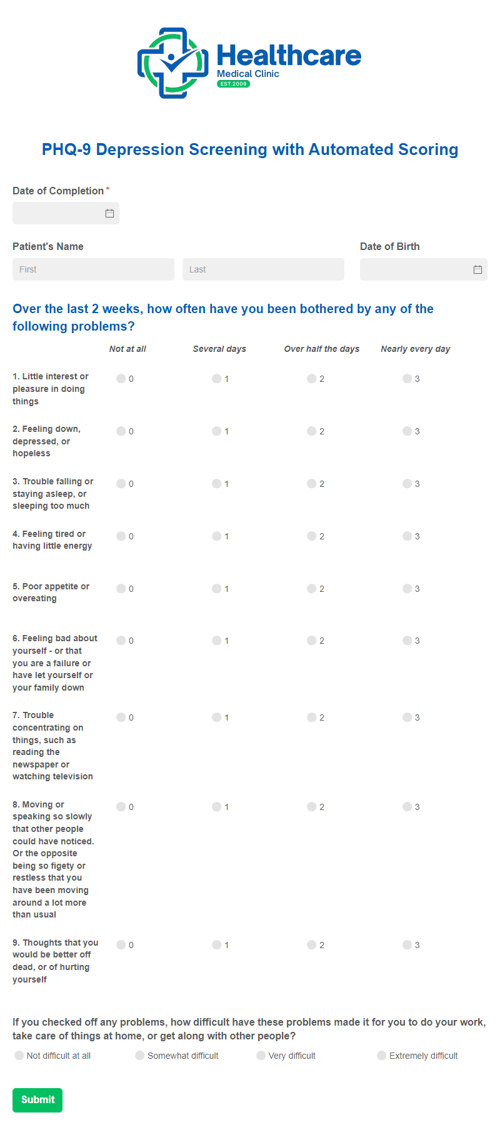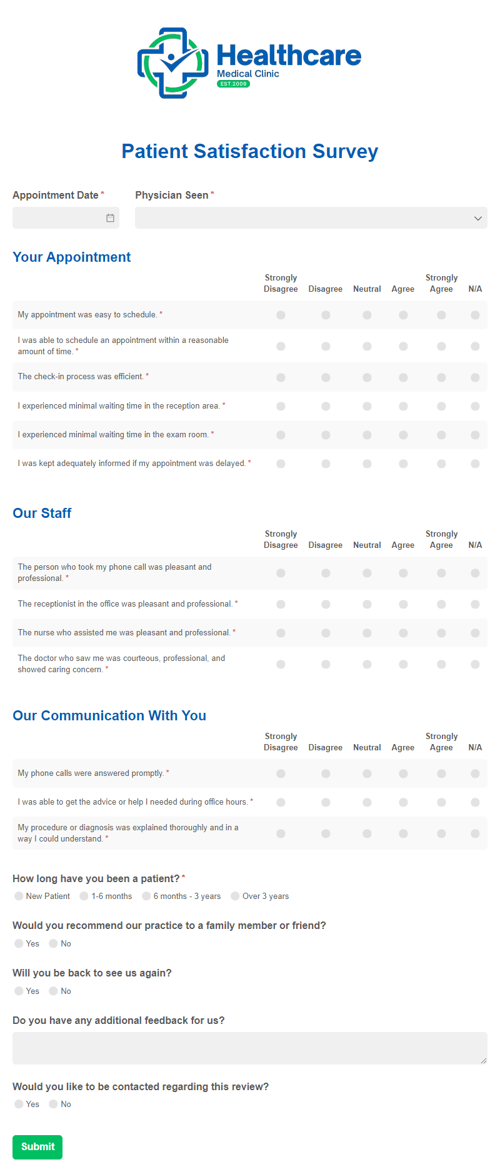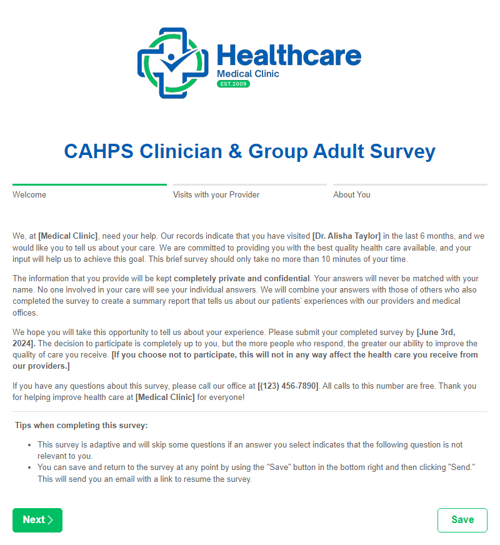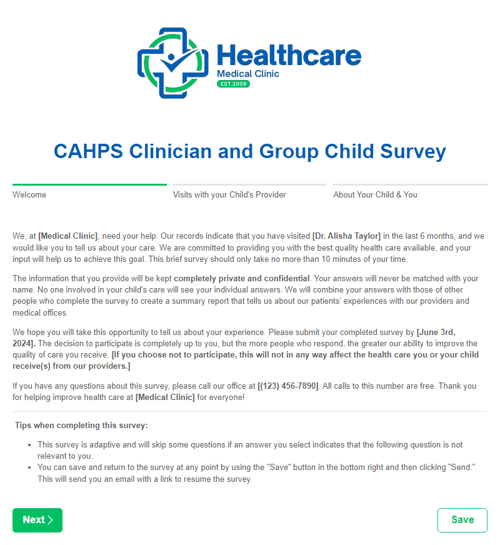Discover how to build custom HIPAA-compliant forms to streamline your healthcare processes.
Technological advancements and digital transformation have quickly become important aspects of our lives. Many industries have started adopting digital technology on a larger scale as they’ve realized the need to increase productivity and efficiency further while also decreasing costs. Like many other data-driven industries, the healthcare industry is also evolving and adapting at a rapid pace by incorporating technology in numerous ways. In the article, The Real-World Benefits of Digital Transformation in Healthcare, Karl Forsberg, the author and a Healthcare IT Executive, says it well: “Healthcare providers have been embracing digital technologies to streamline their workflows, improve patient outcomes, and reduce costs. From telemedicine to electronic health records (EHRs), digital transformation has revolutionized the way healthcare services are delivered.”
In addition to increasing efficiency for staff and patients, reducing costs, and improving population health management, one of the most important healthcare technology benefits is improved data security and privacy. Digital platforms, with tools such as secure messaging, two-factor authentication, and data encryption capabilities, can help protect patient information from data breaches and cyber threats. These features enable healthcare organizations to rest easy knowing that they’re putting their best foot forward regarding their patients’ privacy.
"Around 97% of our patients complete their intake forms digitally through Cognito Forms, prior to the time of their appointment."

The expectation to keep patient data secure is common practice, no matter the type of healthcare organization. With the Health Insurance Portability and Accountability Act of 1996 – better known as HIPAA – came a set of national standards for protecting certain health information. When these new regulations were put into place, they required healthcare organizations to make many changes, including where and how data is stored and who has access to it. In today’s world, HIPAA compliance and the security of patient data are at the forefront of providers’ and administrators’ minds as they make decisions about patient data. With many new software and programs available to medical practices, it’s important to know how these companies ensure the security of your data when using their product. Let’s dive deeper into a few areas to consider when selecting and using software for your healthcare practice.
Ensuring Security and Privacy of Patient Data in Online Forms
Although unfortunate, data breaches occur more commonly than we think. Cyberattacks, phishing scams, and stolen information scams have increased over the past decade, and even a tiny vulnerability could harm your organization. According to this article by Fortinet, “A data breach is an event that results in confidential, private, protected, or sensitive information being exposed to a person not authorized to access it.” Anyone can be at risk of data breaches, from individuals to government institutions, and anyone can put others at risk if they’re not protected or accidentally mishandle the data. As we start incorporating digital technology into our lives and processes, as Kaspersky highlights, “There are more places for data to slip through. New technologies are being created faster than we can protect them.” This is why it’s imperative to ensure that the platforms you use are safe and secure, especially when dealing with customer or patient data.
Data breaches can happen for various reasons, including accidental or deliberate malicious insiders, lost or stolen devices, or cyberattacks (such as phishing malware). Data breaches can often unintentionally occur when patient data is compromised or accidentally shared with someone who shouldn’t have access to that data. The security within your healthcare practice is only as strong as your weakest link. Because of this, it is crucial to ensure that the platforms you use are secure and encrypted and that everyone who works with confidential data knows how to handle it and follows proper protocol.
A journal article published in the National Library of Medicine states, “Hacking/IT incidents are the most prevalent forms of attack behind healthcare data breaches, followed by unauthorized internal disclosures.” What does this mean for you? Well, while it’s vastly important that the software you use has a high level of security itself, the ability to control user access is an additional and necessary layer of protection. Without the ability to control who has access to data or specific sections of a patient’s form submission, you don’t have the highest level of security possible with your patient data.
You can use various protocols to prevent data breaches, such as setting strong passwords, using multi-factor authorization and secure URLs that typically begin with HTTPS, and educating staff members about cybersecurity and common attacks. Although it is impossible to guarantee that data breaches will not occur even after you’ve taken all the necessary precautions, it truly does help reduce the risk of these incidents occurring. Genetec, a security technology company, states, “Organizations have three critical tools at their disposal to ensure strong cybersecurity: encryption, authentication, and authorization.” Let’s look deeper into each of these three areas that better ensure the security of your data.
Encryption
Because anyone can potentially expose your data to risks, it’s essential to ensure that encryption methods are in place, no matter the state of your data. Data encryption ensures data is encoded and cannot be accessed by unauthorized users. Genetec states it well: “In essence, when your data is encrypted, even if an unauthorized person or entity gains access to it, they will not be able to read it.” Data in transit tends to be most vulnerable to attacks when it is active and transmitted between devices or networks. This is when it is out of the user’s control. Similarly, it is also possible for data at rest to be susceptible to attacks even if it is not moving. This is why it is important to ensure that your data is encrypted as much as possible, no matter its state. Many cloud-based software platforms choose to encrypt sensitive data when in transit, automatically protecting your data at these points. When protecting your data at rest, it’s important to ensure that whatever platform you’re using has additional features to encrypt it, helping ensure maximum data security.
Authentication
One common form of authentication for online platforms is multi-factor authentication. This involves adding an additional step to the login process to authorize the login attempt, typically a unique and constantly changing code. These codes are usually sent to your email or external authentication platforms. Amazon Web Services (AWS) states, “Multi-factor authentication acts as an additional layer of security to prevent unauthorized users from accessing accounts, even when the password has been stolen.” Many businesses today use multi-factor authentication to provide additional layers of security and protection to reduce their risk of potential data breaches.
Authorization
Ensuring the right users can access patient data stored in your online platforms is crucial to data security. Healthcare is one industry where permissions and authorization, all the way down to the individual user level, are so important. Authorization at the user level, according to Auth0 by Okta, is when “a computer system defines whether a user has sufficient access privileges to execute an action based on a trait (attribute or claim) associated with that user.” Every employee in your practice does not need to have access to patient data. Instead, only those assigned to a patient’s care team or performing tasks specific to that patient should be authorized. Even then, different users should see various amounts of data depending on their role. Customizing and controlling user permissions and authorization settings are essential to securing your data as much as possible.
These three components can help create a robust data security framework for your organization. Ideally, you should ensure that every online platform you use to house patient data prioritizes protecting and securing that data.
How to Increase Your Data’s Security and Privacy with Cognito Forms
Gathering information online is highly efficient in saving time for both practices and patients. Without proper security measures, any time saved doesn’t matter. When searching for an online form builder or data collection tool, selecting one with high security, HIPAA compliance, and the three previously mentioned data security features is vital. These allow you to control and ensure that only the right people can access patient data at the right times.
Our platform, Cognito Forms, has security and encryption protocols that meet the highest standards and the latest technologies to ensure your data remains private, safe, and secure. Whether during data collection, storage, or transfer, measures are in place to protect against unwanted access, corruption, and loss. Account owners control employee access and can add additional encryption features to all their forms. This allows account owners to elevate the security and privacy of their patient data.
We make it easy for anyone to use our robust features to secure and control access to their data. Advent Health University recommends that healthcare practices “adopt role-based access control (RBAC) to ensure that employees and others can access only the data resources they require to do their jobs.” You can easily provide role-based access using our assigned entry views feature, which gives only certain specified roles access to specific entry views. Additionally, you can set up role-based conditions on fields and sections to allow only the people in the specified role to see that information when accessing an entry on the form.
We also offer even more security and privacy features, including:
- Two-factor authentication (2FA): Two-Factor Authentication adds a second layer of security to your Cognito Forms account and requires you to enter a unique and constantly changing six-digit code every time you log in. You can send these codes through email or another authenticator app.
- Authenticated forms: Authentication requires users to log in with their Cognito Forms username and password before accessing and filling out a form. This prevents unauthorized users from accessing your forms.
- Single sign-on (SSO): SSO enables you to create a secure, simplified login experience for your organization’s users. Once enabled, all users must join or sign in to Cognito Forms with their existing Google, Facebook, or Microsoft accounts.
- Audit log: Audit logs (also known as audit trails) are collected on every entry you receive, recording who acted on the entry and when it occurred. The data in the audit log will go back as far as two years on our Enterprise plan.
- User permission levels: You can control individual user permission levels on the organization, folder, and form levels. This ensures that the right users have the right permissions to make changes and view your account’s information.
Our features enable you to maintain well-rounded data security. By ensuring your patients’ confidential data remains secure, we help you create an even more secure foundation for your relationship with them.
How Cognito Forms Secures and Encrypts Your Data
So, how exactly does Cognito Forms protect your data, and what platforms do we use to accomplish that? All data with Cognito Forms is encrypted at rest using industry best practices and is only ever accessed exclusively over HTTPS, including 256-bit SSL encryption. Our additional data encryption feature adds a second layer of encryption while your data is stored locally - such as when you’re actively working with entry data. This protection uses organization-specific encryption keys and encrypts any cached data in your browser, ensuring your data will remain safe from outside malicious attacks. We also offer individual field protection which prevents data from being unintentionally transmitted out of your account and allows you to automatically protect individual fields, or a section of fields, on your form. We recommend you protect any field containing sensitive or Protected Health Information (PHI), such as social security numbers, driver’s license numbers, or other personally identifiable information.
As previously mentioned, Cognito Forms also offers HIPAA compliance through business associate agreements (BAA), making it easy to build custom forms while ensuring that your patient’s data remains safe and protected no matter what. HIPAA compliance is an extremely useful tool, available on our Enterprise plan, that prompted many of our current healthcare customers to use our product in the first place. One of our customers, Alex Austin from Willamette Health & Wellness, states, “We wanted something HIPAA-compliant and something customizable to let patients fill out forms.” You can always learn more about enabling the HIPAA-compliance feature and establishing a BAA with Cognito Forms on our website.
Research and Customer Insights
With the release of many new and powerful features over the last few years, mixed with the wide variety of ways customers use our product, we noticed a need for more in-depth templates that include industry-specific workflows. Many of our customers, across all industries, have a variety of complex processes within their organization, and we decided to create a tangible starting point for them when first using our product and building new forms. In addition, we showcase how you can further simplify daily tasks and the vast number of things you can accomplish when using Cognito Forms.
To showcase this, we spent extensive time exploring many sectors in healthcare and thoroughly researched how our customers use our platform to transform their processes. The most powerful part of our process, though? The live, virtual interviews we conducted with our customers. These interviews gave us a deeper understanding of the steps involved in different healthcare processes. Customers also helped us learn more about key features and attributes they personally use and which would be most impactful when included in our templates. We were able to personally interact with our customers and gain insights into what healthcare practices need and want from our platform. Inviting customers to play a role in the creation of templates has been a powerful and rewarding experience for us.
Leveraging this research, we now introduce our new research-based healthcare templates. These aren’t your average form templates. They are backed by research and tested by actual customers. All while including powerful pre-built configurations for standard processes within healthcare practices. These innovative templates will help you reinvent your data collection and patient experience with minimal effort.
How You Can Use Cognito Forms in Your Practice
Cognito Forms will transform your practice’s tedious, time-consuming paper and manual processes into easy-to-use yet powerful digital solutions. Provided below are several pre-built form templates that you can easily use and customize:
- Patient registration
- Medical and dental history
- Consent and release forms
- Appointment and prescription refill requests
- Questionnaires and screenings
- Patient satisfaction surveys
Patient registration
Registration is necessary for every patient coming through your office, and many practices consistently have new patients daily. The last thing you want in your office is unhappy patients needing to wait a long time before being seen. According to this study published in the Journal of Informatics Research, one aspect that directly impacts waiting time is how patients register for their appointments. In this study, they compared the waiting time of patients who completed their registration online to those who completed their registration in person. The results concluded that patients who registered in the office waited an average of 8.84 minutes, whereas patients who registered online only waited an average of 4.91 minutes. In other words, a 55% shorter wait time was associated with registering online before their appointment. In addition, they found that a patient’s satisfaction was affected by their waiting time, so they recommended that patients register online to reduce waiting time and increase patient satisfaction.
Additionally, the sheer number of registrations managed by your admin staff can open the door to mistakes and inaccuracies. Since 61% of claim denials are due to simple demographic or technical errors, it’s important to ensure that the information transferred from the patient registration forms to your medical records system is highly accurate. Adopting online patient registration forms reduces the opportunity for errors by eliminating the step of manually transferring information from a paper form into the patient’s chart. Online registration forms minimize patient waiting time and increase patient satisfaction.
Cognito Forms provides your patients with a secure, customizable form-building platform to build comprehensive online registration forms. Our platform enables you to:
- Provide your patients with a convenient registration process using our Save & Resume feature that enables them to save their progress at any point and pick up where they left off.
- Meet all the industry standards in data privacy and security, such as HIPAA, CCPA, GDPR, and US Privacy Shield.
- Keep an organized and secure record of all your new patients and their details using the form’s Entries page.

Wait times in medical offices are an average 55% shorter when registered online.
Dian Nustwantoro University
Real-life example
The Unumb Center for Neurodevelopment focuses on helping individuals with autism reach their full potential by providing comprehensive, evidence-based services, and collaborative solutions for the autism community. Their organization uses Cognito Forms for multiple areas, including patient intake and registration, health history, and consent forms.
Initially, their goal was to digitize their registration forms, but they wanted to ensure that whatever product they used would be fully secure and HIPAA-compliant. Although their EMR did have online forms available, its customization capabilities needed to be improved to better suit their needs. When they first came across Cognito Forms and began using it, they quickly realized how beneficial the product was in addition to hitting all their necessary security requirements.
Online forms have become their new norm, and around 97% of their patients complete their intake forms digitally before their appointment. Their patient intake form is very comprehensive and collects their patients’ contact information, treatment consent, demographics, and more, all in a single multi-page form. This form also includes an internal section for their staff to track whether the patient has been scheduled for an appointment and gives them a space to write down any important notes. Using our conditional logic capabilities, they can hide this section from the patient, making it visible only to their staff members. Cognito Forms has been incredibly helpful to The Unumb Center by streamlining their patient intake process and saving their patients’ time on the day of their appointment.
Reduce errors and save time using our templates.
To get you started with online patient registrations, we created two versions of new patient registration forms–an adult patient registration and a child patient registration . Both templates include sections for basic patient information, demographics, insurance, and emergency contact information. Along with these patient-facing sections, there is an internal section for your staff to track when the registration information has been transferred into your internal system and which staff member completed that task. You can easily modify, add, or delete anything in the template to fit your exact needs.
Medical and dental history
Medical providers see many patients daily, all with various conditions and concerns. Understanding each patient’s health history before proceeding with a treatment or examination is important. Medical history forms typically include many facets of a patient’s history, including medical, surgical, family, and social history, allergies, and current or previous medications. Although sometimes lengthy to fill out, medical and dental history forms help medical professionals better understand a patient’s state of health and make educated decisions on the next steps for treatment. As this article titled, Medical History, from the National Library of Medicine states, “obtaining a medical history can reveal the relevant chronic illnesses and other prior disease states for which the patient may not be under treatment but may have had lasting effects on the patient’s health.”
Although medical and dental history forms have been used for many years, going paperless with these forms can result in many advantages for patients and staff. For example, with digital forms, patients can complete the form ahead of time rather than completing a paper version at the office on the day of their appointment–a task we all know can be extremely tedious. Most of our healthcare customers we interviewed prefer it when their patients fill out the forms online and ahead of time. This creates a smoother and more sustainable process for admin staff because they no longer need to worry about printing or scanning so many paper forms. According to our customers, another significant benefit of digital health history forms is the ability to avoid data entry or legibility issues. Since the text is standardized and easy to read, staff members no longer need to spend time deciphering handwriting and can process the information faster.
Cognito Forms provides you with a platform that can help you further streamline your medical and dental history form processes. Use our platform to:
- Generate a PDF Document of the patient’s submission and easily upload it into your electronic medical record to store your patients’ medical records.
- Easily build your own form or quickly customize our medical or dental history templates to fit your needs – reducing costs and eliminating the need to print or scan forms.
- Enable patients to complete this form on their own time and on any device rather than only in the office on the day of their appointment.
"Cognito Forms helps us gather information in useful ways. It enables us to use conditional logic to filter out questions that certain patients don't need to complete, making our forms less burdensome for some patients."

Alex Austin
Operations Specialist
Willamette Health & Wellness
Real-life example
Willamette Health & Wellness, a healthcare practice specializing in providing mental health care for adults, families, and youth, is a loyal customer of Cognito Forms. Alex Austin, their Operations Specialist, shared that their most significant motivator for going digital was the COVID-19 pandemic. Many of their forms were on paper, and they quickly needed a process to collect patient forms virtually without physical interaction. This pushed them to Cognito Forms to build a customized health history form equivalent to a traditional medical history form. They have three versions of this form based on the patient’s age. These forms help their clinicians learn more about the patient’s background to identify the best treatment methods. Questions on this form directly tie into different patient information, such as demographics, stored in their EHR system.
After transitioning to Cognito Forms and going digital, they could email patients the form ahead of time and ask them to complete it before their appointment. This greatly reduced their patients’ wait time on the day of their appointment and further streamlined the intake process for staff. After their transition, they also noticed how much easier it was for staff members to access completed forms, eliminating the need to pass physical copies back and forth throughout the office. Going digital with Cognito Forms has truly helped them streamline their data collection and collaboration processes.
Cognito Forms provides their organization with many benefits regarding digital forms. Although other platforms they already use offer form-building services, they experienced many limitations when customizing the form’s layout and logic. The pivot to Cognito Forms was an easy decision for them – not only because of our security features, such as data and SSL encryption but primarily because of our HIPAA-compliant form capabilities. They could proceed knowing that they would be protecting their patients’ data and would have the advanced capabilities to customize their forms exactly how they’d like. As Alex mentions, “With this form and all of our Cognito forms, we’ve been able to ask exactly what we want and have dropdowns or logic based on the information we need, which can help the form look cleaner than when [patients] receive a paper copy that has a ton of questions that may not be relevant.” Going digital and using a secure, HIPAA-compliant platform like Cognito Forms has greatly helped Willamette Health & Wellness go digital and improve their practice’s operations.
Digitize your medical and dental history forms with Cognito Forms today.
To help you get started, we've created two different versions of medical history forms as well as a dental health history form. All three of our templates are well-researched and include all the essential fields you would expect on a medical or dental history form. The adult medical history form is intended for adults and includes questions about their prior and current general health, while the child medical history form is specifically tailored for pediatric patients and includes questions pertinent to children and teenagers. The dental health history form is for patients of any age and collects a patient's general dental information. All the templates also include an internal section for your staff to keep track of each entry's progress along the way.
Consent and release forms
Some of the most used forms in medical practices are those completed for consent and information release. These forms are legal documents to ensure consistent communication between patients and healthcare providers. However, consent forms and release forms are both used for different purposes.
Consent forms
In healthcare organizations, there are generally two types of consent forms: general and informed consent. General consent forms are typically signed during patient registration, giving providers authorization for general examination, treatment, etc. On the contrary, informed consent forms are usually signed before a specific treatment or procedure and, according to The American Cancer Society, help ensure healthcare providers give patients information about their condition, testing, and treatment options before deciding what to do.
Medical release forms
The HIPAA Journal states, “A signed HIPAA release form must be obtained from a patient before their protected health information can be shared with other individuals or organizations.” These release forms are completed and signed by patients when they’d like to share medical records or other protected health information from one provider to another. These forms give providers legal consent to share this information. As a note, medical release forms are often referred to with different names, including medical records release, release of information forms, authorization forms, and HIPAA forms.
Using online platforms for consent and release forms can reduce the number of errors made when processing and interpreting the information indicated on a form. A study conducted by the American Society of Clinical Oncology found that the “paper-based method of documenting patient consent was associated with an error rate of 7% (24 of 343 forms),” whereas “e-consent was associated with an error rate of 0.32% (18 of 5,600).” This error rate reduction is likely due to the elimination of staff reading and interpreting handwritten forms. Using electronic forms, they would no longer need to transfer the form’s information into a digital system. Eliminating the step of transferring information also eliminates situations in which errors are more likely, thus reducing the number of errors overall.
Cognito Forms is an excellent option to set up your digital consent and release forms and cut back on errors associated with these forms. Our platform has everything you need to:
- Collect electronic signatures on any device, making it easier for your patients to complete the form and saving your staff time when processing it.
- Show or hide additional signature fields based on the individual signing the form using our easy-to-use conditional logic capabilities.
- Easily match your practice’s branding guidelines using form Themes.
Consent Form Error Rates


How practices use Cognito Forms for medical records requests.
Healthcare practices receive many requests daily to release medical records, but these forms must be sent and received securely. Paper versions of these forms can be even riskier since patient data might be more challenging to keep entirely private. Rather than having patients scan and email copies of their paper forms to the office, patients can enter their information directly into a secure and encrypted online form. Receiving the patient’s request online makes it easy for your staff to gather the information and reach out to the appropriate party to request or send any records quickly and accurately.
Many practices using Cognito Forms for patient records release requests use our Data Encryption feature on their forms. While the data in your patients’ submissions is always encrypted in transit, you have the ability to encrypt entry data and add a second layer of encryption, protecting data at rest. Enabling this feature in your forms ensures your data always remains safe and secure. You can also protect individual fields on a form with sensitive information, such as a social security number (SSN).
In addition to data encryption, many customers use features such as single sign-on (SSO), two-factor authentication (2FA), and role-based entry views. These features add a layer of security to users’ accounts and ensure only the right people can access new entries. SSO and 2FA add layers of protection to the login process. In contrast, role-based entry views enable you to select additional role-based permissions on entry views and ensure only users assigned to the specific role can access the entries in the view.
Our customers use our platform for consent and release forms in many ways, with several different combinations of features. These different form setups are unique to each organization and use case, but we have several features to ensure you have what you need when building your forms.
Set up your consent and release forms online using our templates.
Quickly digitize your current consent and release forms using our pre-built templates. We have an adult medical consent form, a child medical consent form, and a medical release form ready for you! The consent forms have general verbiage and should be updated to match your practice's policies and legal text. The medical release form includes fields to collect all information required by HIPAA to release information or records. All information in these templates can easily be modified, added, or deleted to fit your needs.
Appointment and prescription refill requests
Living in a digital time where we can order anything from food to clothing without leaving our couch or picking up the phone is a true luxury. Naturally, people expect to be able to do the same when it comes to managing their health, such as refilling medications or scheduling medical appointments. While some people still don’t mind calling their doctor’s office to do these things, most expect the option to complete these tasks at the click of a button.
Appointment requests
In general, appointment request forms can be highly beneficial to both the patient and the provider. Combining the simplicity of a contact form with the efficacy of a booking form, these forms allow your patients to request appointments online based on their availability, even after hours. Traditionally, patients would have to call your office during working hours to schedule an appointment, which isn’t always convenient, especially when working full-time or with a hectic schedule. Appointment request forms enable patients to complete forms on their own time. These forms could also positively impact staff members by reducing the number of phone calls they receive and helping them focus on other tasks at hand. In turn, this can help your office run more smoothly, especially if your office is short-staffed. As Ashley Hohensee and Scott Zeitzer write in this article by P3, practices can update “their automated hold message to let patients know they could request an appointment via the website. This is a great way to let patients know that the option is available if they can’t or don’t want to wait on hold and helps to reduce the number of patients waiting on hold for your staff to answer.” Small measures such as these can result in positively impactful changes when introducing an appointment request form.
Prescription refill requests
Similarly, online prescription refill request forms make it easy for patients to request prescription refills on the go without calling the office or speaking to anyone. This makes it easier for your staff to manage the details digitally by no longer needing to relay the information given to them on the phone and enter it into another system. With this change, your staff can focus more on processing the request than listening to voicemails. Email communications and notifications can be sent out from the form itself, keeping your patient in the loop about their refill status and simplifying the overall process for you.
There are many benefits to transitioning to a digital platform for your appointment and prescription refill requests. Cognito Forms makes it easy to go digital and streamline these processes. No matter the request form, Cognito Forms helps:
- Digitize your appointment and prescription refill request processes and allow your patients to complete these forms on their own time.
- Allow staff members to view and update the status of any request as they process them in a centralized location.
- Staff members track the progress of an appointment request or prescription refill so they know exactly where it is in the process.
Cognito Forms enhances our level of patient care by maximizing face-to-face time with providers, rather than providers needing to read patient forms during visits.
Brian
Real-life example
Our customer, Brian, is an IT Coordinator for a pediatric primary care and urgent care clinic. As the IT Coordinator, Brian helps maintain the clinic’s computer systems and interfaces between their providers and EMR. One of their physicians discovered Cognito Forms about five years ago when they were experiencing some limitations with their EMR system.
Their organization first introduced medication refill request forms to speed up the prescription refill request process for patients and staff. Before going digital, if staff could not answer the phone, patients had to sit on hold and leave voicemails with their details. This can be frustrating for patients at that moment and cumbersome for the staff members going through the voicemails later. Brian finds that their new medication refill request form through Cognito Forms allows patients to submit their information easily and allows providers to receive the information faster and act upon it, as opposed to playing phone tag or interpreting voicemails. While they still have patients who prefer to call to request prescription refills, they encourage all their patients to use the online form whenever possible. That way, physicians can spend more time providing patient care than answering phone calls, which they believe is one of the most significant benefits of using digital forms.
Alex Austin, the Operations Specialist at Willamette Health & Wellness, spoke to us about an appointment request form they made using our platform. Their form allows patients seeking care to submit their interest in an appointment and provide staff with more information about themselves. Their staff then uses the information in the completed form to go through and check if any medical professionals are available to see and treat the patient without the hassle of listening to voicemails or calling people back. This eliminates the need for patients to call the clinic to request an appointment and allows their staff to efficiently complete tasks related to these requests. Using conditional logic, they also included a hidden section specifically for staff members to make notes and updates regarding the status of each request. Using an online appointment request form has dramatically reduced the time their staff spends on repetitive, menial tasks and allows them to focus more on patient care.
Quickly set up digital request forms for your medical practice.
Easily convert any paper processes at your healthcare organization to a digital format using our appointment request and prescription refill request templates. Our request form templates are created to streamline your manual processes, and both forms also include an internal section for your admin staff to keep track of each submission's status and progress. Our ready-to-use templates are easily customizable, so feel free to change the workflow structure or add and edit fields as you see fit.
Questionnaires and screenings
Many different types of questionnaires and screenings are used in the healthcare space. These are intended to help doctors diagnose different conditions or even help healthcare social workers identify patients’ areas of need. While practices use different questionnaires for various purposes, two extremely common questionnaires in primary care offices are the GAD-7 and PHQ-9. These questionnaires help doctors understand the patient’s background and symptoms related to General Anxiety Disorder or depression. The U.S. Preventative Services Task Force officially recommends that primary care physicians use screening tools, such as the GAD-7 and PHQ-9, to help in catching Generalized Anxiety Disorder or depression as early as possible.
No matter the type of questionnaire you need for your patients, our platform makes it quick and easy for you to transition your questionnaires online. Online questionnaires are convenient for patients to complete and can reduce costs by no longer buying paper. Cognito Forms provides the ability to:
- Provide patients with a mobile-responsive version of your frequently used questionnaires so they can be completed on any device anytime.
- Automatically calculate scores using our calculation fields, reducing your manual work.
- Easily generate a PDF of the patient’s completed questionnaire to upload to your EMR.
- Send entry details elsewhere using our third-party integrations.
- Format your questions in different ways using our many field types, including rating scales, dropdowns, checkboxes, textboxes, and more.
"Our questionnaire forms automatically calculate the score now, whereas before, clinicians needed to spend time manually calculating the score."

Alex Austin
Operations Specialist
Willamette Health & Wellness
Real-life example
As previously introduced, Alex Austin works for Willamette Health and Wellness, a mental health clinic in Oregon. After using Cognito Forms for their appointment requests, they realized the need to recreate their frequently used GAD-7 and Depressive Symptomology questionnaires digitally. Every patient seen by their providers must complete both questionnaires before their appointment, so it’s essential these forms are easy for patients and providers to use. One of Alex’s favorite aspects of their questionnaires is their use of Calculations. She explained their experience using Calculation fields, stating, “We have the form calculate the score automatically, whereas, before, clinicians needed to spend time manually calculating the score.” Since these questionnaires traditionally require staff to add up the score manually, automatic calculations save their staff a significant amount of time. It also makes it quicker for a provider to view the results and make appropriate medical decisions.
Additionally, our customer, Brian, who we mentioned earlier, uses Cognito Forms in a similar way. Their practice has created online questionnaires, such as a Vanderbilt assessment, mental health screenings, infant development questionnaires, and asthma control tests. All these standardized questionnaires or screenings are used to help providers better diagnose patients. Their organization also added automated scoring using our Calculation fields, but they’ve taken this above and beyond with additional conditional logic on specific fields within the form. These fields are Content fields that only appear when the patient has answered certain questions with a particular response, automatically alerting their doctor(s) to review these pieces of information. This saves their doctors’ time because it quickly indicates if the patient’s answers are of concern or require further review. Overall, their clinic makes it convenient for patients to complete their questionnaires while providing their doctors with a quick and intuitive way to review the completed form.
Introduce online questionnaires in your practice in no time.
We've created online versions of the GAD-7 Anxiety Questionnaire and the PHQ-9 Depression Questionnaire for you to get started, and both templates include all the questions listed in their official paper-version counterpart. Our templates also include automated scoring calculations, so your staff doesn't need to worry about adding the scores up manually each time. Additionally, you can easily download a PDF of the patient's responses to store in your electronic medical records.
Patient satisfaction surveys
Patient satisfaction surveys are critical to administering quality health care and provide indicators to measure health care quality and delivery. Additionally, the results of these surveys can affect various factors such as “clinical outcomes, patient retention, and medical malpractice claims," as this study in the National Library of Medicine states. Providing high-quality and stellar care has always been a goal for medical professionals and staff. With an increased emphasis placed on patient-centric care, the importance of patient satisfaction has skyrocketed. The same research study goes on to mention how “patient satisfaction is thus a proxy but a very effective indicator to measure the success of doctors and hospitals.” Surveys are an excellent way for practices and clinics to ensure they provide positive experiences and high levels of patient care.
A common satisfaction survey that healthcare facilities use is the Consumer Assessment of Healthcare Providers & Systems survey, also known as the CAHPS survey. These surveys typically ask patients about their experiences with healthcare providers and plans such as doctors, hospitals, home healthcare agencies, health and drug plans, etc. As this article on CMS.gov highlights, these “surveys focus on matters that patients themselves say are important to them and for which patients are the best and/or only source of information.” Slightly different from general patient satisfaction surveys, CAHPS surveys “focus on how patients experienced or perceived key aspects of their care, not how satisfied they were with their care.” They focus more on “asking patients whether or how often they experienced critical aspects of health care, including communication with their doctors, understanding their medication instructions, and the coordination of their healthcare needs” rather than amenities. The results from CAHPS surveys help monitor healthcare providers’ performance, reward them for quality care, and determine areas for improvement. These surveys also provide patients with information to select physicians and healthcare providers.
No matter the survey you need to create, Cognito Forms has you covered. Our platform is an excellent option for you to set up your digital surveys in a streamlined manner and all in one spot. We provide you with everything you need to:
- Build a variety of digital and online surveys that make it easier for your patients to answer the questions and provide feedback on their own time and on any device.
- Create custom surveys with built-in and automated scoring using our robust Calculation fields.
- Format your survey using various field types, including Rating Scales, Checkboxes, Textbox fields, and much more.
Patient satisfaction is a very effective indicator to measure the success of doctors and hospitals.
National Library of Medicine
Real-life example
As previously introduced, The Unumb Center for Neurodevelopment provides high-quality, evidence-based services to individuals with autism and their families. In addition to their patient intake form, they also use our platform for patient satisfaction surveys. Their survey is intended for patients’ families to provide feedback regarding their overall experience and satisfaction working with medical professionals from The Unumb Center. The families can share their names or remain anonymous, and all responses received are shared with their doctors afterward.
Their patient satisfaction survey is a multi-page, highly comprehensive form that captures feedback regarding different aspects of the doctor and the care their child has received. Most of the questions are asked using Choice fields with answer options from “Strongly Disagree” to “Strongly Agree.” Their form does a great job targeting multiple facets of the doctor and the care given, allowing their patients to share their feedback openly. Overall, the form they’ve created helps their organization ensure they provide the highest level of care possible.
Use Cognito Forms to build custom surveys for your practice.
To help you start building surveys for your practice, we’ve created the following templates. First, we’ve created a general patient satisfaction survey . Easily adjust or modify the form to include questions specific to your practice, and even download a PDF of the patient’s responses to store in your EMR or medical files.
We’ve also created a couple of digital versions of CAHPS surveys. Although there are various types of CAHPS surveys that measure a patient’s experience, the templates we’ve created for you are the CAHPS Clinician & Group Surveys - a CAHPS Clinician & Group Adult survey and a CAHPS Clinician & Group Child survey . These specific versions of the CAHPS survey ask patients to provide feedback on their experiences in primary and specialty care settings. Each CAHPS template includes automated scoring, making it easier for your team to view the score immediately after completion.
Cognito Forms is Secure and Cost-Effective
We know the privacy and security of patient data is always your number one priority. Cognito Forms provides an intuitive form-builder that keeps patient data secure and HIPAA-compliant on our Enterprise plan. Our security protocols meet the highest standards, and we have measures to protect against unwanted access, corruption, and loss, whether your data is in transit or at rest. Alongside these features, we help you go digital, streamline your manual processes, and boost your overall productivity. Cognito Forms’ mixture of solid data security protocols, comprehensive customization features, and affordable prices make it a fantastic choice for your secure and custom form needs.
